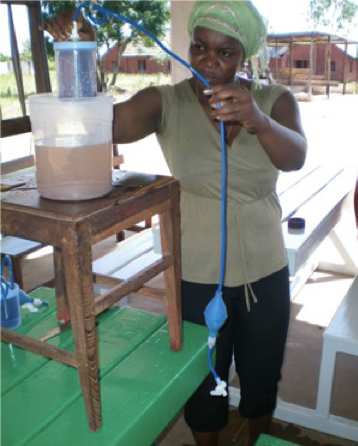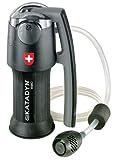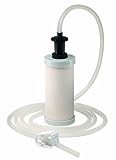
Clean water is vital to off-grid living, and only the lucky minority can depend on easy access to flowing water or a proper well. Most will be pleased with rainwater or a trickle of dirty water on their land, which they can then filter before use.
Adding a siphon to a gravity fed water filter improves the water flow. This article discusses the way a siphon works with a ceramic water filter cartridge but the general principal applies to other water filter technologies as well.
What is a siphon? A siphon is simply a length of hose that is added to the output of the filter where the water normally drips out. The dimensions of the tube are critical. The inside diameter needs to be small enough that the tube can completely fill with water. The outside diameter of the tube needs to form a good seal with the filter. The length of the tube should be at least a foot long but can be much longer if needed. Ideally it should rest on the bottom of the container.
The inside diameter needs to be small enough that the tube can completely fill with water. The outside diameter of the tube needs to form a good seal with the filter. The length of the tube should be at least a foot long but can be much longer if needed. Ideally it should rest on the bottom of the container.
How does a siphon work? A siphon forms a vacuum that pulls water through the filters much like a syringe. This vacuum force is in addition to the normal force of gravity but is much stronger. This is proven by the fact that a siphon can counteract gravity and pull water uphill (as long as the eventual outlet is lower than the water inlet). In a gravity drip bucket system, the addition of a siphon can more than double the water flow rate over simple gravity alone. It has also been proven to improve the flow rate of low pressure systems. See the table below.
Setting up a siphon In a simple gravity feed system, setting up a siphon is very easy. You simply insert the hose into the filter outlet and drop the other end into the clean water receptacle. Initially, gravity will force water through the filter, but instead of dripping into the bucket it will begin to fill the siphon hose. When the hose is filled the siphon is formed. As the water exits the siphon it creates a vacuum which pulls more water into the hose.
Troubleshooting Since the siphon is such a simple device there are just a few problems that can arise. The most common is if there is a bad seal at the inlet and air is pulled in instead of water. If this happens the flow rate will slow down to just the normal gravity feed rate. However if you use clear hose for the siphon it is very simple to troubleshoot. (If you see air in the line you have a bad seal or the tube is damaged). One simple fix that often works is to simply stretch the tube out slightly with the end of a pen or pencil and then reinstall it into the filter. If that still does not work a small dab of plumber’s putty should do the trick.
A second problem that can happen is if the feed rate of the filter is too slow to fill the siphon tube, This may be an indication that the filter needs to be cleaned or replaced or it may mean that the inside diameter of the siphon hose is too large.
The third problem that can happen is if the siphon is damaged or blocked. Again if you are using a clear tube it should be easy to perform a visual inspection. Check to see if there is anything blocking the tube or if the tube has any splits in it.
Once the siphon is set up properly it will work wonderfully: no electricity needed, no manual pumping, no batteries to change out, and still a lot more clean water available.
Summary Siphons are a low-tech, low-cost way to more than double the flow rates of water filters. Regardless of whether you use siphons or not, everyone should have backup water purification capability just in case things happen. Most folks have flashlights, weather radios, and first aid kits stored somewhere for emergencies and water availability should be in the same category.
One Response
thank you this really helped me alot